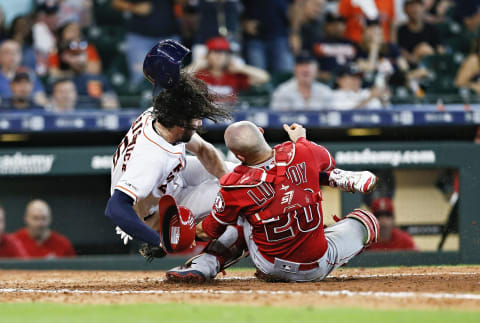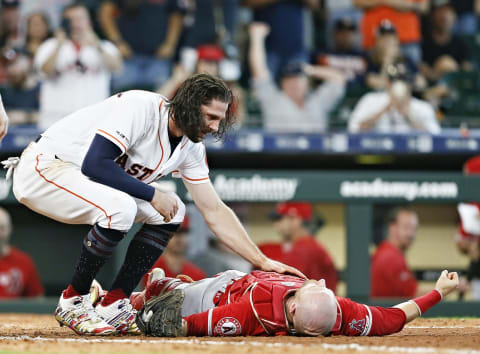MLB gets it wrong on suspending Astros’ Marisnick for collision

Major League Baseball wrongly suspended Astros outfielder Jake Marisnick two games for his home plate collision with Jonathan Lucroy.
When Astros outfielder Jake Marisnick and Angels catcher Jonathan Lucroy collided at home plate on Sunday, immediate reaction was strong from multiple sides. With such a violent incident resulting in Lucroy getting hurt, it was guaranteed that MLB would look into it.
I called it a few days ago. I knew MLB would suspend Marisnick, even though I firmly believe he did nothing to deserve it. Now, of course, MLB has suspended him for two games, though its reasoning is flawed at best. It overshadows what should be a happy time for this Astros team, with its players’ strong performance in the All-Star game.
The Rule
MLB Rule 6.01(i) concerning home plate collisions states, “A runner attempting to score may not deviate from his direct pathway to the plate in order to initiate contact with the catcher…or otherwise initiate an unavoidable collision.”
Part Two of the rule states, “Unless the catcher is in possession of the ball, the catcher cannot block the pathway of the runner as he is attempting to score.” There are some nuances to these rules, which we can look at in the context of this particular collision.
In part, Joe Torre’s explanation states, “While I do not believe that Jake intended to injure Jonathan, the contact he initiated in his attempt to score violated Official Baseball Rule 6.01(i), which is designed to protect catchers from precisely this type of collision.”

The Play
First of all, I join everyone in sending my best wishes to Lucroy for a speedy recovery. But looking at the play and looking at the rule, it’s impossible to ignore the fact that Lucroy was blocking the plate before he had possession of the ball. This is in direct violation to Part Two of the rule.
Further, the comment to Part One of the rule states, “If a catcher blocks the pathway of the runner, the umpire shall not find that the runner initiated an avoidable collision in violation of this Rule.” Based on Torre’s comment, MLB’s basis for suspending Marisnick is an assertion that he initiated an avoidable collision, but that assertion is false.
It’s true that the comment also states that “the runner’s lowering of the shoulder…would support a determination that the runner deviated from the pathway in order to initiate contact with the catcher.” Marisnick did lower his shoulder, which is what makes it look egregious at first glance. But a further examination tells a different story.
When Lucroy is blocking the plate while waiting for the ball, he makes a slight move toward the outside (e.g., toward the backstop). When Marisnick sees this, he makes the decision to go to the inside, as he himself explained. Once this happens, Lucroy’s attempt to catch the ball also pulls him back toward the inside and right into Marisnick’s path.
By that point, it was too late for Marisnick to change course. He was running at full speed and simply could not avoid the collision. So, instinctually, he lowered his shoulder in order to protect himself, rather than colliding headfirst with Lucroy.
Part Two of the rule does state that “it shall not be a violation of this Rule 6.01(i)(2) if the catcher blocks the pathway of the runner in a legitimate attempt to field the throw,” but Lucroy had been blocking the plate before the throw came in.
Further, it states “a catcher without possession of the ball shall not be adjudged to violate this Rule 6.01(i)(2) if the runner could have avoided the collision…by sliding.” But with Lucroy positioning himself right in front of the plate, where was Marisnick supposed to slide? In fact, he attempted to slide to the inside under the belief that Lucroy was going to the outside, which unfortunately turned out to not be the case.

The Aftermath
More from Climbing Tal's Hill
- Houston Astros: A Lineup Change to Spark Offense
- Astros prospect Hunter Brown throws 6 shutout innings in debut
- Always faithful Astros World Series champion Josh Reddick defends the title
- Michael Conforto declines Astros’ 2-year, $30 million offer
- Alex Bregman goes off in August, leads Astros
In hindsight, it would have been better if Marisnick had slid to the outside, but it’s wrong to penalize a player when he tried to avoid the contact, but contact happened anyway. Sometimes these things happen, no matter how many rules you make. It’s unfortunate, but it’s clear that what happened here was accidental.
MLB’s desire to suspend Marisnick seems to be based solely on the fact that Lucroy got hurt, and that they want to eliminate these types of collisions. That’s all well and good, but if anyone here violated the rules, it’s Lucroy. Would he have been suspended if Marisnick had been hurt instead? Somehow I doubt it.
The intent of the rule should be to simply eliminate situations where a runner intentionally bulldozes a catcher. You can’t eliminate accidental collisions and it’s wrong to penalize a player for something that was clearly an accident. The fact that the suspension was only for two games clearly shows MLB didn’t think it was intentional, but wanted to suspend him anyway so it can tout how much it supports player safety.
The message MLB is sending here is that as a baserunner, you have an obligation to not touch a catcher, even when he’s blocking your path. I’m not sure how the runner is supposed to score in that situation, but evidently that is of minimal concern. The league seems more concerned with its image than with doing right by its players.
Marisnick has appealed the MLB ruling and will be eligible to be in Houston’s lineup for this evenings game.
Next. Astros could possibly pursue Zack Wheeler. dark
Frankly, I’m not even sure why the rule exists if MLB isn’t going to follow it. Lucroy blocked Marisnick’s path, resulting in an unintentional collision. Shame on the league for suspending Marisnick, though Astros fans have come to expect nothing better from the Commissioner’s office over the years.